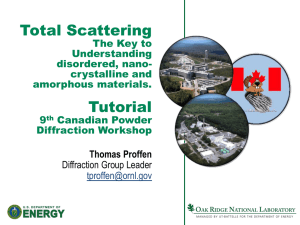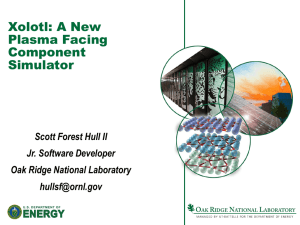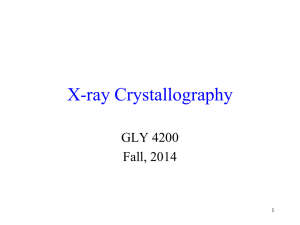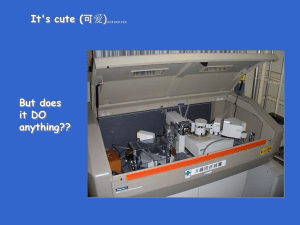Modeling of disordered structures
advertisement
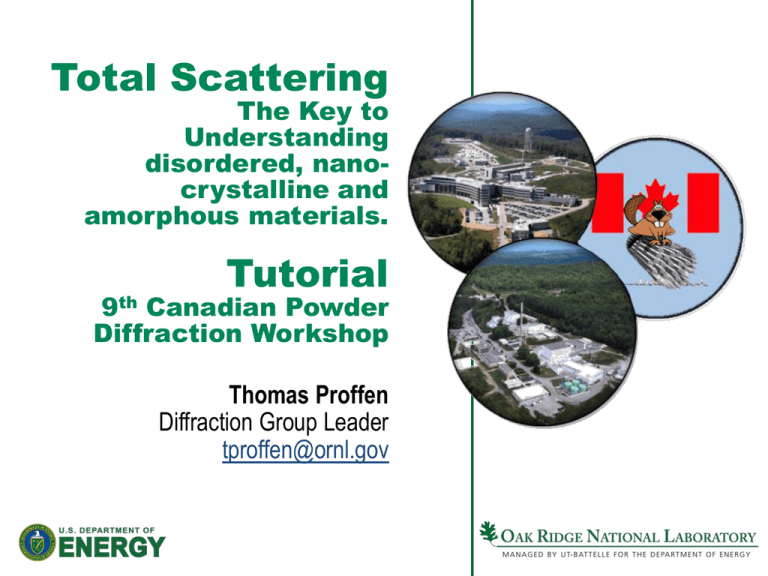
Total Scattering
The Key to
Understanding
disordered, nanocrystalline and
amorphous materials.
Tutorial
9th Canadian Powder
Diffraction Workshop
Thomas Proffen
Diffraction Group Leader
tproffen@ornl.gov
Friday 25th May 2012
9:00 - 9:45
9:45 - 10:30
Beyond the Bragg peaks or why do we care about total
scattering?
Measuring total scattering X-ray and neutron data: where
and how?
10:30 - 11:15
Break
11:15-12:30
What to do with your PDF: Modeling of disordered
structures ?
12:30 - 1:30
Lunch
1:30 - 5:00
Practical Sessions
All cartoons by
Julianne Coxe.
2
Managed by UT-Battelle
for the U.S. Department of Energy
9th Canadian Powder Diffraction Workshop – May 23-25, 2012
University of Saskatchewan, Saskatoon.
Modeling
Total Scattering
3
Managed by UT-Battelle
for the U.S. Department of Energy
9th Canadian Powder Diffraction Workshop – May 23-25, 2012
University of Saskatchewan, Saskatoon.
Data modeling
‘PDFFIT’ style
4
Managed by UT-Battelle
for the U.S. Department of Energy
9th Canadian Powder Diffraction Workshop – May 23-25, 2012
University of Saskatchewan, Saskatoon.
Software: Data modeling
PDFgui
Part of DANSE project.
http://www.diffpy.org/
Calculation and refinement of small model
system (< 1000 atoms)
‘Rietveld’ type parameters: lattice
parameters, atomic positions,
displacement parameters, ..
New possibilities: Refinements as function
of r range !
Automatic refinement of multiple datasets
as function of T or x.
Intuitive GUI.
Engine pdffit2 can also be used in
command mode.
5
Managed by UT-Battelle
for the U.S. Department of Energy
9th Canadian Powder Diffraction Workshop – May 23-25, 2012
University of Saskatchewan, Saskatoon.
Calculating a PDF ..
• Calculating a PDF from a structural model:
bi b j
G ( r ) 2 ( r rij ) 4r0
ij
b
• Thermal motion
– Small crystal convolution of (r-rij) with
distribution function (PDFFIT)
– Large crystal actual displacements &
ensemble average (DISCUS)
• Termination ripples
– Multiplication with step function in
reciprocal space gives convolution with
sin(Qmaxr)/r in real space.
6
Managed by UT-Battelle
for the U.S. Department of Energy
9th Canadian Powder Diffraction Workshop – May 23-25, 2012
University of Saskatchewan, Saskatoon.
PDF analysis: Individual peaks
PDF peak width of InAs
uncorrelated
correlated
Correlated motion results in
sharpening of near neighbor PDF
peaks.
Calculated PDF without “” of InAs
Empirical correction
c 0 / r2 / r
Future: Extraction of phonons ??
Jeong et al., J. Phys. Chem. A 103, 921 (1999)
7
Managed by UT-Battelle
for the U.S. Department of Energy
9th Canadian Powder Diffraction Workshop – May 23-25, 2012
University of Saskatchewan, Saskatoon.
Calculating a PDF: PDFfit
PDF calculated according to
In more detail
8
Managed by UT-Battelle
for the U.S. Department of Energy
bi b j
G ( r ) 2 ( r rij ) 4r0
ij
b
9th Canadian Powder Diffraction Workshop – May 23-25, 2012
University of Saskatchewan, Saskatoon.
Effects of Q resolution on the PDF
• Assuming Gaussian resolution function leads to dampening of PDF:
1 2 2
exp − 𝑟 𝜎𝑄
2
• Assuming ΔQ/Q constant leads to PDF peak broadening at high r:
𝜎 = 𝜎0 + 𝛼𝑟 2
9
Managed by UT-Battelle
for the U.S. Department of Energy
9th Canadian Powder Diffraction Workshop – May 23-25, 2012
University of Saskatchewan, Saskatoon.
High r PDF refinement – Ni on NPDF
• No corrections
– Rw = 32%
– a = 3.5259Å
– Uiso = 0.00852Å2
• Dampening
– Rw = 20%
– a = 3.5259Å
– Uiso = 0.00762Å2
• Damp. & Broadening
– Rw = 11%
– a = 3.5261Å
– Uiso = 0.00506Å2
10
Managed by UT-Battelle
for the U.S. Department of Energy
9th Canadian Powder Diffraction Workshop – May 23-25, 2012
University of Saskatchewan, Saskatoon.
Example:
Local atomic strain in ZnSe1-xTex
Simon Billinge (Columbia)
Thomas Proffen (LANL)
Peter Peterson (SNS)
11
Managed by UT-Battelle
for the U.S. Department of Energy
9th Canadian Powder Diffraction Workshop – May 23-25, 2012
University of Saskatchewan, Saskatoon.
ZnSe1-xTex : Structure
Zinc blend structure (F43m)
Technological important :
Electronic band gap can be tuned
by the composition x.
Bond length difference Zn-Se and
Zn-Te strain.
Local structural probe required !
12
Managed by UT-Battelle
for the U.S. Department of Energy
9th Canadian Powder Diffraction Workshop – May 23-25, 2012
University of Saskatchewan, Saskatoon.
ZnSe1-xTex : Total scattering
Peterson et al., Phys. Rev. B63, 165211 (2001)
Behaves like
average structure
Behaves like
local structure
13
Managed by UT-Battelle
for the U.S. Department of Energy
9th Canadian Powder Diffraction Workshop – May 23-25, 2012
University of Saskatchewan, Saskatoon.
ZnSe1-xTex : Nearest neighbors
BLUE: XAFS from Boyce et al., J. Cryst.
Growth. 98, 37 (1989); RED: PDF results.
14
Managed by UT-Battelle
for the U.S. Department of Energy
9th Canadian Powder Diffraction Workshop – May 23-25, 2012
University of Saskatchewan, Saskatoon.
Data modeling
‘PDFFIT’ style
R-dependent refinements
15
Managed by UT-Battelle
for the U.S. Department of Energy
9th Canadian Powder Diffraction Workshop – May 23-25, 2012
University of Saskatchewan, Saskatoon.
Refinement range – length scales in
structure
• Simulated structure of
20x20x20 unit cells.
• Matrix (M): blue atoms
• Domains (D): red atoms,
spherical shape, d=15Å.
• Simulated using DISCUS.
Th. Proffen and K.L. Page, Obtaining Structural
Information from the Atomic Pair Distribution
Function, Z. Krist. 219, 130-135 (2004).
16
Managed by UT-Battelle
for the U.S. Department of Energy
9th Canadian Powder Diffraction Workshop – May 23-25, 2012
University of Saskatchewan, Saskatoon.
Refinement range – length scales in
structure
O=15%
• Top: Single-phase
model with blue/red
fractional occupancies
(O).
• Bottom: Refinement of
same model for 5Å wide
sections.
• Extensions:
O=29%
O=16%
– Multi phase models
– Modeling of boundary
– R-dependent refinable
mixing parameters
17
Managed by UT-Battelle
for the U.S. Department of Energy
9th Canadian Powder Diffraction Workshop – May 23-25, 2012
University of Saskatchewan, Saskatoon.
O=15%
O=15%
O=15%
Example:
Local structure in LaxCa1-xMnO3
Simon Billinge
Emil Bozin
Xiangyn Qiu
Thomas Proffen
18
Managed by UT-Battelle
for the U.S. Department of Energy
9th Canadian Powder Diffraction Workshop – May 23-25, 2012
University of Saskatchewan, Saskatoon.
LaMnO3: Jahn-Teller distortion
Jahn Teller
Long Mn-O bond
Local structure
Average structure
• Mn-O bond lengths are invariant with temperature, right up into the R-phase
• JT distortions persist locally in the pseudocubic phase
• Agrees with XAFS result: M. C. Sanchez et al., PRL (2003).
19
Managed by UT-Battelle
for the U.S. Department of Energy
9th Canadian Powder Diffraction Workshop – May 23-25, 2012
University of Saskatchewan, Saskatoon.
Refinement as function of
atom-atom distance r !
X. Qiu, Th. Proffen, J.F. Mitchell and
S.J.L. Billinge, Orbital correlations in
the pseudo-cubic O and
rhombohedral R phases of LaMnO3,
Phys. Rev. Lett. 94, 177203 (2005).
20
Managed by UT-Battelle
for the U.S. Department of Energy
9th Canadian Powder Diffraction Workshop – May 23-25, 2012
University of Saskatchewan, Saskatoon.
LaMnO3 : T-dependence of orbital
clusters from PDF
rmax(Ǻ)
• Diameter of orbitally ordered domains above TJT is 16Ǻ
• Appears to diverge close to TJT
• Red lines are a guide to the eye (don’t take the fits too seriously!)
21
Managed by UT-Battelle
for the U.S. Department of Energy
9th Canadian Powder Diffraction Workshop – May 23-25, 2012
University of Saskatchewan, Saskatoon.
LaMnO3: Simplicity of the PDF approach
700 K data (blue) vs 750 K data (red)
30s
Distortions persist locally!
22
Managed by UT-Battelle
for the U.S. Department of Energy
9th Canadian Powder Diffraction Workshop – May 23-25, 2012
University of Saskatchewan, Saskatoon.
23
Managed by UT-Battelle
for the U.S. Department of Energy
9th Canadian Powder Diffraction Workshop – May 23-25, 2012
University of Saskatchewan, Saskatoon.
PDF
Refinements
(nano particles)
24
Managed by UT-Battelle
for the U.S. Department of Energy
9th Canadian Powder Diffraction Workshop – May 23-25, 2012
University of Saskatchewan, Saskatoon.
Software: Data modeling
DISCUS
Disordered materials simulations
Refinement via DIFFEV / RMC
http://discus.sourceforge.net/
Oxford University
Press, October 2008
25
Managed by UT-Battelle
for the U.S. Department of Energy
9th Canadian Powder Diffraction Workshop – May 23-25, 2012
University of Saskatchewan, Saskatoon.
Enhanced local dipoles in
5nm BaTiO3
Rietveld analysis for ferroelectric bulk BaTiO3
unambiguosly supports tetragonal (polar)
symmetry. For the nanoparticle data,
tetragonal (P4mm) and cubic (Pm-3m)
perovskite models are indistinguishable.
Are small BaTiO3 particles polar?
Total scattering clearly supports local polar
symmetry (P4mm) symmetry. In addition the
ligand structure can be readily observed.
K. Page, T. Proffen, M. Niederberger, and R. Seshadri, Enhanced local dipoles in
BaTiO3 nanoparticles, Chem Mater., in press
26
Managed by UT-Battelle
for the U.S. Department of Energy
9th Canadian Powder Diffraction Workshop – May 23-25, 2012
University of Saskatchewan, Saskatoon.
Modeling of nanoparticle data / current
Using PDFgui
Calculation and refinement of small
model system (< 1000 atoms)
‘Rietveld’ type parameters: lattice
parameters, atomic positions,
displacement parameters, ..
New possibilities: Refinements as
function of r range !
http://www.diffpy.org/
Nanoparticle case
Nanoparticle is modeled as bulk with a
formfactor for the limited shape.
Ligands are modeled as single
molecules in box and no particle/ligand
correlations are included.
27
Managed by UT-Battelle
for the U.S. Department of Energy
9th Canadian Powder Diffraction Workshop – May 23-25, 2012
University of Saskatchewan, Saskatoon.
Gold nanoparticles (revisited)
• Nanoparticles often show different
properties compared to the bulk.
2nm
• Difficult to study via Bragg diffraction
(broadening of peaks).
• PDF reveals “complete” structural
picture – core and surface.
• This study:
50 nm
– 5nm monodisperse Au nanoparticles
– 1.5 grams of material
– Neutron measurements on NPDF
28
Managed by UT-Battelle
for the U.S. Department of Energy
9th Canadian Powder Diffraction Workshop – May 23-25, 2012
University of Saskatchewan, Saskatoon.
Gold nanoparticles: First NPDF data
Bulk gold
Gold nanoparticles
Average diameter ~3.6nm
29
Managed by UT-Battelle
for the U.S. Department of Energy
9th Canadian Powder Diffraction Workshop – May 23-25, 2012
University of Saskatchewan, Saskatoon.
K.L. Page, Th. Proffen, H.
Terrones, M. Terrones, L.
Lee, Y. Yang, S. Stemmer,
R. Seshadri and A.K.
Cheetham, Direct
Observation of the
Structure of Gold
Nanoparticles by Total
Scattering Powder
Neutron Diffraction,
Chem. Phys. Lett. 393,
385-388 (2004).
Modeling Au structure only
300 K: Rw = 33.8 %
•scale =
•a =
•uiso(Au) =
•δ1 =
•d =
0.2121(5)
4.0753(1)
0.01267(6)
1.980(7)
26.13(7) Å
15 K: Rw = 27.8 %
•scale =
•a =
•uiso(Au) =
•δ1 =
•d =
0.2070(4)
4.06515(5)
0.0044(2)
2.257(5)
25.54(4) Å
This is the conventional PDF nanoparticle approach… no ligand modeling.
30
Managed by UT-Battelle
for the U.S. Department of Energy
9th Canadian Powder Diffraction Workshop – May 23-25, 2012
University of Saskatchewan, Saskatoon.
Modeling Au structure & ligand
CF3(CF2 )5(CH2 )2S-
Au-S
300 K: Rw = 31.4 %
•scale (Au) =
•scale (molecule) =
•a (Au) =
•a(molecule) =
•uiso(Au/molec) =
•δ1 (Au) =
•srat (molecule)=
0.2082(5)
0.0485(6)
4.0755(1)
49.40(3)
0.01227(5)
1.953(7)
0.02(3)
15 K: Rw = 24.7 %
•scale (Au) =
•scale (molecule) =
•a (Au) =
•a(molecule) =
•uiso(Au/molec) =
•δ1 (Au) =
•srat (molecule)=
0.2054(4)
0.0604(6)
4.06500(5)
49.23(2)
0.00433(2)
2.256(6)
0.03(14)
~1 Mol./110 Å2 particle surface
UNCLASSIFIED
31
Managed by UT-Battelle
for the U.S. Department of Energy
+
9th Canadian Powder Diffraction Workshop – May 23-25, 2012
University of Saskatchewan, Saskatoon.
Modeling of nanoparticle data - future !
Using DISCUS/DIFFEV
Oxford University
Press, October 2009
http://discus.sourceforge.net/
Approach: The particle is modeled as a whole.
Current work on gold nanoparticles: An fcc Au particle is
constructed in DISCUS, we select a cuboctahedron.
Ligands (with ‘internal’ structure as constructed with DFT
minimization) are located randomly at the particle
surface with a defined surface density and defined Au-S
distance, orientated out from the particle center.
Evolutionary algorithm is used to refine model
parameters above (CPU intensive).
32
Managed by UT-Battelle
for the U.S. Department of Energy
9th Canadian Powder Diffraction Workshop – May 23-25, 2012
University of Saskatchewan, Saskatoon.
Nanoparticle builder
Page, K., Hood, TC, Proffen, T, Neder, RB,
J. Appl. Cryst., 44 (2), 327 - 336 (2011)
33
Managed by UT-Battelle
for the U.S. Department of Energy
9th Canadian Powder Diffraction Workshop – May 23-25, 2012
University of Saskatchewan, Saskatoon.
Work in progress …
Things to consider
•Particle size distribution
•Variations in ligands
•Ligand-ligand interactions ?
•Ligand floppiness
•...
r(A)
34
Managed by UT-Battelle
for the U.S. Department of Energy
9th Canadian Powder Diffraction Workshop – May 23-25, 2012
University of Saskatchewan, Saskatoon.
Example: ZnSe nanoparticles
nanocrystalline ZnSe
crystalline ZnSe
as narrow as crystal
nano
crystal
broader than crystal
35
Managed by UT-Battelle
for the U.S. Department of Energy
9th Canadian Powder Diffraction Workshop – May 23-25, 2012
University of Saskatchewan, Saskatoon.
Example: ZnSe nanoparticles
structural coherence
loss of coherence due
to stacking faults
36
Managed by UT-Battelle
for the U.S. Department of Energy
9th Canadian Powder Diffraction Workshop – May 23-25, 2012
University of Saskatchewan, Saskatoon.
Example: ZnSe nanoparticles - Model
create a large single Wurtzite layer A/B
Stack along c (with faults)
Cut to proper size
Calculate PDF / powder pattern
Repeat and average
Repeat with new set of parameter
using a Differential Evolutionary Scheme
{110} and {001}
37
Managed by UT-Battelle
for the U.S. Department of Energy
Software: DISCUS and DIFFEV
9th Canadian Powder Diffraction Workshop – May 23-25, 2012
University of Saskatchewan, Saskatoon.
Example: ZnSe nanoparticles - Results
C. Kumpf, R.B. Neder et al., Structure
determination of CdS and ZnS nanoparticles:
Direct modeling of synchrotron-radiation
diffraction data, J. Chem. Phys. 123, 224707
(2005).
exp
calc
• Results:
– a=3.973Å, c=6.494Å
– Diameter ~26Å
– Stacking fault prob. 70%
38
Managed by UT-Battelle
for the U.S. Department of Energy
9th Canadian Powder Diffraction Workshop – May 23-25, 2012
University of Saskatchewan, Saskatoon.
What is next ??
Neder et al.; Chory et al.; Niederdraenk et
al. Physica Status Solidi C 4, (2007)
• Systematic studies (samples !)
Locally epitaxial
Random placement
• Extensions
– Anisotropic shapes
– Complex architectures (core-shell)
• Software
– Nanoparticle Builder
– Other refinement strategies
– Using more complementary data
– http://discus.sourceforge.net
CdSe - ZnS core-shell
(R. Neder, U Erlangen)
39
Managed by UT-Battelle
for the U.S. Department of Energy
9th Canadian Powder Diffraction Workshop – May 23-25, 2012
University of Saskatchewan, Saskatoon.
Nanoparticle builder
http://totalscattering.lanl.gov/nano/
40
Managed by UT-Battelle
for the U.S. Department of Energy
9th Canadian Powder Diffraction Workshop – May 23-25, 2012
University of Saskatchewan, Saskatoon.
Nanoparticle builder – in action ..
41
Managed by UT-Battelle
for the U.S. Department of Energy
9th Canadian Powder Diffraction Workshop – May 23-25, 2012
University of Saskatchewan, Saskatoon.
RMC
Shaking a big box of
atoms.
Courtesy of M. Tucker,
ISIS
42
Managed by UT-Battelle
for the U.S. Department of Energy
9th Canadian Powder Diffraction Workshop – May 23-25, 2012
University of Saskatchewan, Saskatoon.
Reverse Monte Carlo
• Commonly used to model glasses and liquids (no
long range order).
• Recently applied to disordered crystalline materials.
• Large model structures.
• Importance of constrains.
• Uniqueness of solution ?
R.L. McGreevy and L. Pusztai, Reverse Monte Carlo Simulation: a New
Technique for the Determination of Disordered Structures , Mol. Simul.
1, 359-367 (1988).
M.G. Tucker, M.T. Dove and D.A. Keen, Application of the Reverse Monte
Carlo Method to Crystalline Materials , J. Appl. Cryst. 34, 630-638
(2001).
43
Managed by UT-Battelle
for the U.S. Department of Energy
9th Canadian Powder Diffraction Workshop – May 23-25, 2012
University of Saskatchewan, Saskatoon.
RMC: How does it work ?
Initial fit
to data
with
starting
values
Reverse
Monte
Carlo
algorithm
44
Managed by UT-Battelle
for the U.S. Department of Energy
Change a
variable
at
random
Calculate new fit
to data χ2
If
worse
If
better
Keep change
with a certain
probability
Keep
change
Repeat until an acceptable
fit is obtained
9th Canadian Powder Diffraction Workshop – May 23-25, 2012
University of Saskatchewan, Saskatoon.
Adding constraints
| Fcalc(Q i) Fexpt (Qi ) | /
2
2
F ( Qj )
j
| Tcalc(ri ) Texpt (ri ) |2 / 2 T ( r )
j
2
j
| rSi O RSi O | /
2
2
Si O
Si O
| θO Si O ΘO Si O |2 / 2 O Si O
O Si O
| I expt (tj ) sI calc (tj ) |2 / I2( t )
j
j
+ anything else you can calculate from the
configuration of atoms
45
Managed by UT-Battelle
for the U.S. Department of Energy
9th Canadian Powder Diffraction Workshop – May 23-25, 2012
University of Saskatchewan, Saskatoon.
Include Bragg intensities ..
RMCProfile calculates the
intensities and then produces
the profile.
Use GSAS to fit :
Peak shape
Background
Lattice parameters
| I expt (tj ) sI calc (tj ) |2 / I2( t )
j
I(t)
j
3.5
3
2.5
2
1.5
1
0.5
0
7000
9000
11000
13000
15000
tof(ms)
46
Managed by UT-Battelle
for the U.S. Department of Energy
9th Canadian Powder Diffraction Workshop – May 23-25, 2012
University of Saskatchewan, Saskatoon.
17000
Example: SF6
(010) Section of SF6 at 50K
47
Managed by UT-Battelle
for the U.S. Department of Energy
(010) Section of SF6 at 190K
9th Canadian Powder Diffraction Workshop – May 23-25, 2012
University of Saskatchewan, Saskatoon.
Polyhedral Restraints
•
Tetrahedra
•
Octahedra
•
Tetrahedra & Octahedra
•
Chains
| rSi O RSi O |2 / 2 Si O
Si O
| θO Si O ΘO Si O |2 / 2 O Si O
O Si O
3
•
Triangles
Over restrained
RMC
Expt
2.5
RMC
Expt
Normal
2.5
•
2
Tether
2
•
1.5
and more
1.5
1
Weighting is weak
to hold things
together while the data
chooses the final shape
1
0.5
0.5
0
0
1.6
1.8
2
2.2
-0.5
48
Managed by UT-Battelle
for the U.S. Department of Energy
9th Canadian Powder Diffraction Workshop – May 23-25, 2012
University of Saskatchewan, Saskatoon.
1.6
-0.5
1.8
2
2.2
RMC: Examples
SF6
SrTiO3
ZrW2O8
AuCN
49
Managed by UT-Battelle
for the U.S. Department of Energy
9th Canadian Powder Diffraction Workshop – May 23-25, 2012
University of Saskatchewan, Saskatoon.
Software: RMCprofile
• RMCprofile
– Atomic configurations ~600 to 20000+
atoms
– Fit both X-ray and neutron F(Q)
– Fit G(r)
– Fit Bragg profile (GSAS tof 1,2 & 3)
– Polyhedral restraints
– Coordination constraints
– Closest approach constraints
• Produce a static 3-D model of the
structure (a snap-shot in time)
• Link: http://www.isis.rl.ac.uk/RMC
50
Managed by UT-Battelle
for the U.S. Department of Energy
9th Canadian Powder Diffraction Workshop – May 23-25, 2012
University of Saskatchewan, Saskatoon.
• Nanoparticle modeling tutorial at ACA meeting: July 28, 2012 in
Boston. http://totalscattering.lanl.gov
• DISCUS workshop: Sep. 10-13,2012 U Erlangen (Germany).
http://discus.sourceforge.net
DISCUS workshop 2010
Erlangen
51
Managed by UT-Battelle
for the U.S. Department of Energy
9th Canadian Powder Diffraction Workshop – May 23-25, 2012
University of Saskatchewan, Saskatoon.
